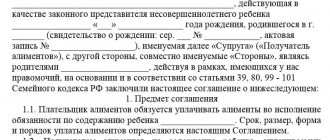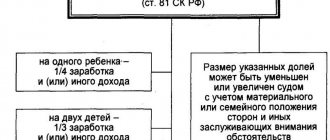Lawyer Ruzanna Khanamiryan told the Federal News Agency what child support you can count on in 2021, and how to get your hard-earned money from a negligent defaulter.
Love passes, but children remain, and if a wife can become an ex, then children never do. After a divorce, the spouse (or, less often, but still happens, the spouse) has a number of obligations to his family. Ideally, he or she should take an active part in raising the child, but in reality, more and more often the situation is such that children do not see not only attention and walks in the parks on weekends, but also the most necessary things.
Despite the fact that the state is constantly tightening punishment for defaulters, and bailiffs are competing in ingenuity, trying to appeal to the conscience of draft dodgers, the number of those who leave their own children without a livelihood is only growing. Neither photographs on “honor boards”, nor an appeal to the employer, nor a ban on traveling abroad, nor even the arrest of accounts (which, it must be said, often do not exist at all) help. We discussed the problem with expert lawyer Ruzanna Khanamiryan, and received useful comments from her about the amount of alimony, as well as the rights and obligations of the parties.
Federal News Agency (FAN)
How is the cost of living related to the amount of alimony?
The subsistence level is considered to be the minimum amount required to meet the priority needs of a specific group of the population: children, pensioners, people of working age.
In cases where the court assigns child support in a fixed amount (Article 83 of the Family Code of the Russian Federation), its amount will directly depend on the level of the subsistence minimum. If in a particular region the size of the monthly minimum is not established at the regulatory level, then the amount that applies throughout Russia is taken as a basis.
In addition, Art. 117 of the RF IC determines that payments are subject to indexation in proportion to the increase in the amount of the subsistence minimum (must be carried out every quarter).
Note: when determining the amount of child support payments as a share of the salary (Article 81 of the RF IC), there is no direct dependence on the cost of living. Here, the amount of alimony will be influenced by the amount of earnings of the alimony obligee.
Can the amount of alimony be less than the minimum subsistence level?
The court may set the amount of alimony below one monthly minimum.
When assigning alimony payments, the court, as a rule, takes as a basis the provisions of Art. 61 of the RF IC, which states that parents are equally obliged to support their children. Based on this norm, the courts assign child support in a fixed amount of money in the amount of half the subsistence level. It is understood that the second half of the amount for priority needs must be provided by the parent with whom the child (or children) lives together.
When determining the amount of payments, 2 factors are primarily taken into account:
- The degree of need of the plaintiff. If the parent with whom the child lives has a significant income, then he needs less financial support than one who does not have any income.
- The level of solvency of the defendant. In cases where the person liable for alimony does not have a permanent income or earns the minimum, the court cannot completely deprive him of his means of subsistence.
Note! The courts are also guided by paragraph 27 of the Resolution of the Plenum of the Armed Forces of the Russian Federation dated December 26, 2017 No. 56 “On the application of legislation by courts...”. It says that the amount of alimony is set taking into account the maximum possible preservation of the previous standard of living for the child. Less than half of the PM may be prescribed if the payer has a poor financial situation or cannot pay ½ of the PM due to family circumstances. He must prove all this in court.
Collection of alimony for the maintenance of parents
Collection of alimony in a fixed amount
Special cases of increasing alimony
For a detailed analysis of the features of changing the amount of alimony, it is enough to familiarize yourself with practical examples.
Increase in alimony when the payer’s salary is gray
Gray wages are wages where part of the earnings is officially listed according to documents, and part is given to the employee and does not appear anywhere. As a rule, unofficial payments significantly exceed the official amount.
In such a situation, the claimant will have to prove the fact of gray earnings by contacting the tax service with a request to conduct an audit, and also take official data on the average salary in the region from Rosstat.
Example from practice: Petrova O.N. is raising a 10-year-old daughter. She was given alimony in the amount of 25% of her father's earnings. He is employed in an LLC, officially earns 15,000 rubles, unofficially – 80,000 rubles.
To increase the amount of payments, O.N. Petrova requested a salary certificate from the accounting department at her ex-husband’s place of work. They contained only official data. Then the woman appealed to the Federal Tax Service with a complaint about the taxpayer’s employer violating Tax legislation.
The audit revealed that the payer actually received unofficial income. Petrova O.N. asked for copies of the conclusion and resolution on bringing to administrative responsibility in order to use them as evidence. A request was also made to Rosstat.
According to statistics, the average salary by profession of a defendant in the region is 60,000 rubles. This amount was used to calculate alimony.
In her claims, the woman petitioned for the establishment of fixed payments at the subsistence level - 12,500 rubles. After studying the documents and arguments, the claim was granted.
Increase in alimony if the payer is disabled
It is problematic to request an increase in alimony from payers on disability - they themselves need financial support. Here it is possible to recover additional expenses for the maintenance of children:
Agapova L.D. has a 12-year-old son. In 2021, he was involved in an accident, the driver was ordered to pay compensation, but it was not enough for treatment. Then the woman decided to collect additional funds from her ex-husband, a group 2 disabled person. Over the course of 2 months, she collected checks and receipts for a total of 50,000 rubles. In court, she demanded to recover 50% of the expenses from the man, i.e. 25,000 rubles.
The payer's disability pension is 9,500 rubles, of which 2,375 rubles. He pays monthly in the form of alimony. The claim was satisfied, the man was obliged to compensate for part of the expenses incurred for the child, but was allowed to transfer money in small monthly payments, taking into account his state of health.
Calculation of alimony from the subsistence level
The amount is calculated taking into account the cost of living if the court orders maintenance in a fixed amount. As a rule, for this purpose they take the cost of living in a particular region and divide it in half. This position is explained by the fact that both parents must support their child equally. Exceptions are situations where the claimant has a minimum income, and the defendant has the opportunity to pay more than this amount.
If the cost of living has not been established in a particular region, then the all-Russian indicator is taken into account.
Calculation example.
The monthly minimum wage per child in the region is 12,000 rubles. If the court satisfies the requirement to collect alimony in the amount of ½ monthly minimum, the payer will transfer 6,000 rubles monthly.
You can also file a statement of claim demanding the recovery of 0.8 PM, for example. Under the same conditions, payments will increase to 9,600 rubles:
12,000 x 0.8 = 9,600 rub.
What to do when alimony is below the subsistence level?
In situations where the amount of monthly payments for child support is below the subsistence level, it is realistic to demand an increase in alimony in court.
In this case, the plaintiff must justify the need for such an increase and confirm it with documents. You can file a claim in court an unlimited number of times. The main thing is to have strong evidence that the child needs more funds for normal life and development than was determined by the previous court decision. It is also important to argue that the ex-spouse has the opportunity to increase the amount of maintenance.
Let's sum it up
Thus, it is practically impossible to prove the misuse of alimony, as well as to bring the recipient of funds to certain liability under the current legislation of the Russian Federation. The alimony provider can only ask the court to transfer up to half of the payments to a separate children's account - only the child has the right to dispose of the accumulated amount when he turns 18 years old. However, this resolution should not worsen the living conditions of the minor child, otherwise the court will refuse the proposal.
Also, a man can try to take the child for himself, and then the mother will become the child support provider. In difficult situations, when a woman poses a threat to minor children, her parental rights should be deprived and the child should be taken to her own living space.
In any case, you may need professional advice from a lawyer who will explain the possible course of action and the legal consequences of the actions taken.
Reasons for increasing the amount of payments
The grounds for reviewing the amount of alimony for a minor include the following:
- a significant decrease in the income of the recipient of alimony payments - this may occur if the amount of monthly earnings decreases;
- loss of source of income - most often the reason for job loss is staff reduction;
- deterioration in the health of the parent receiving alimony - in cases where serious treatment costs are required, the person cannot allocate the same amount to support the child;
- rapid rise in prices for consumer goods - provided that the income of the alimony recipient has not changed upward;
- death of a person who provided financial assistance to the recipient of alimony payments - most often this role is played by parents;
- the emergence of new dependents, whose maintenance is the responsibility of the recipient of alimony - in this situation we may be talking about the need to provide financial support to disabled parents (other relatives) or the birth of the next child.
Important! You can apply for an increase in alimony for a minor if the income of the alimony obligee has increased significantly or his obligations for material support of other persons have been terminated (for example, in the case of the coming of age of children to whom alimony was previously paid; the death of disabled recipient parents).
How to collect alimony in the amount of the subsistence minimum in court?
In order to achieve the recovery of amounts the amount of which will be equal to 1 PM (or to increase the amount of assigned payments), you should draw up a statement of claim and file it with the court.
Satisfaction of claims is possible if the defendant has a good income, and it is not possible to provide the child with a normal standard of living without alimony in the amount of 1 monthly wage.
Note: sometimes alimony is collected based on a court order. But it is impossible to achieve payments in a fixed amount of money in a simplified manner: according to paragraph 3 of the Resolution of the Plenum of the Supreme Court of the Russian Federation dated December 26, 2021 N 56, Moscow “On the application of legislation by courts when considering cases related to the collection of alimony”, through an order proceedings will not be able to recover payments in the amount of a fixed amount, since this requires checking the presence or absence of circumstances indicating the possibility of recovery in this way. They are indicated in Art. 83 RF IC.
Is it possible to reduce alimony debt?
Lost income and couldn't pay bills? For the unemployed, alimony is calculated based on the average salary in the region. For regular non-payment, a penalty is imposed in the amount of 1/2% of the amount owed for each day or 182% for the year. For evasion of payments, criminal liability is provided, with a term of imprisonment of up to 1 year.
Such cases are considered in court. Only if there is a good reason, the court will make a positive decision.
- Loss of a job (downsizing, liquidation of an enterprise) Voluntary dismissal is not considered a valid reason and will be regarded as negligence.
- Temporary disability due to serious illness.
- Financial difficulties (for example, delays in wages. Or the cost of caring for persons in care due to serious illness).
Termination of alimony obligations
- If the child reaches 18 years of age (the age of majority).
- In case of transfer to the payer for trusteeship;
- If a child over 16 years of age is working. Let’s make a reservation right away that the court will cooperate in such a situation if the payer is a pensioner, disabled or has a low income.
- In case the child is not in need. For example, has income from the rental of owned real estate or securities.
How to increase the amount of alimony to the subsistence level and above?
You can count on an increase in the amount of alimony payments in cases where the parent with whom the child lives (most often the mother), cannot, taking into account the assigned maintenance, provide him with the same standard of living.
If we analyze the reasons outlined above for revising alimony payments in the direction of increasing maintenance for one’s minor child, then this is realistic in 2 cases:
- If there are negative changes in the financial situation of the alimony recipient.
- When the payer's monthly income increases.
Step-by-step instruction
If the plaintiff can confirm the above circumstances, it is necessary:
- Draw up a statement of claim for the recovery of child support in the amount of one monthly wage or a share of the monthly wage.
- Send one copy of the application and one copy of the prepared documents to the defendant.
- Wait for notification when the defendant receives the documents.
- Submit an application with the remaining documents to the court, and in a few days receive a decision on acceptance for proceedings.
- Go to meetings. First, a preliminary hearing is scheduled, then a trial.
- Receive a decision and wait for it to take effect. In-person proceedings begin in a month, in absentia – 7 days from the date of delivery of a copy to the defendant.
You also need to pick up the writ of execution from the court and present it at the defendant’s place of work. If you don’t want to go there, the claimant has the right to contact the bailiff directly.
How to file a claim for alimony in the amount of the subsistence minimum?
In order to correctly draw up an application demanding the recovery of child support in the amount of the subsistence minimum, it is necessary to be guided by the provisions of the Civil Procedure Code.
The application must include the following points:
- the name of the court whose competence includes the consideration of such disputes;
- information about the plaintiff - this includes personal data of the parent with whom the child remained to live, date of birth, his address and contact information;
- information about the defendant - contains personal data of the potential alimony payer, date of birth, address, telephone number where he can be contacted;
- content of the claim - includes a description of the circumstances in connection with which it became necessary to demand participation in the maintenance of the minor from the second parent;
- justification of the requirements contained in the application - here it is necessary to prove that an amount of at least the subsistence minimum is required for the maintenance of the child, attaching documents confirming this;
- references to the norms of the current legislation - first of all, they refer to the norms of the Family Code, which establish the obligation of parents to support their minor children, and also the regulations that fix the cost of living in a certain region must be indicated.
Sample claim
Documentation
The following documents must be attached to the statement of claim for the recovery of alimony in the amount of the subsistence minimum:
- a copy of the plaintiff's passport;
- copies of marriage and divorce certificates;
- a copy of the child's birth certificate;
- copies of documents confirming that the financial situation of the recipient of alimony payments has worsened - this could be a certificate of monthly earnings, a copy of the work record book with a notice of dismissal, an extract from an outpatient card or medical history;
- certificate of residence – confirms the fact that the claimant and the child live at the same address;
- calculation of alimony payments - if we are talking about increasing their size, then the existence of such a need should be justified.
When calculating the amount required for the maintenance of a minor child, one should also take into account the growth of needs, taking into account individual characteristics (health status, the need for sanatorium treatment, the presence of talents, the development of which requires additional costs.)
Which court should I go to?
Previously, it was possible to collect alimony through the magistrate's court. Now city and district courts deal with such cases.
Note: the plaintiff can file an application with the court at his place of residence on the basis of Part 3 of Art. 129 Code of Civil Procedure of the Russian Federation.
How to file a claim for an increase in alimony?
Procedure for going to court:
- A package of documents is being collected. Certificates confirming the need for increased payments will be required. If the method of collection changes, confirmation of the plaintiff’s need is not necessary.
- A statement of claim is drawn up and submitted to the court along with the documents.
- The parties receive notification of the appointed date of the court hearing - it arrives in writing or via SMS.
- Hearings are being held. The judge takes into account all the circumstances to make an objective decision. If it is determined that the plaintiff does not need increased payments or the defendant earns too little, the claim will be partially satisfied or rejected.
- The plaintiff receives an extract from the court decision and a writ of execution. The IL is transferred to the bailiffs or to the payer’s place of employment.
Claims are considered individually and must be supported by documentary evidence. Even if the plaintiff has a really bad financial situation, this does not guarantee the satisfaction of the claim: it may turn out that the defendant earns less and he himself does not have enough money to live.
Who can apply?
Depending on the specific situation, the following may go to court:
- biological parents of the child,
- guardians or adoptive parents,
- child protection.
Most often, the initiators of going to court are recipients of alimony, but payers can also apply for an increase if:
- Previously, they had child support obligations to other children, but now they have been stopped and they have the opportunity to pay more
- Additional income appeared: from renting out an apartment, making a profit from valuable deposits, etc.
Documents attached to the claim
When filing a claim you will need:
- passport;
- certificates of registration and divorce;
- children's birth certificates;
- salary certificates;
- work book if the plaintiff is laid off due to layoffs and needs financial support.
The court clerk makes copies of the documents, and the originals are given to the owner.
The validity period of the writ of execution for alimony lasts until the child reaches adulthood.
Arbitrage practice
Judicial practice in cases of increasing alimony is ambiguous: the court’s decision directly depends on the circumstances that the parties appeal to when considering the case. For example, the decision of March 16, 2017 in case No. 02-0054/419/2017:
The plaintiff went to court with a request to change the amount of payments from shared to fixed, since the defendant constantly changes his place of work, which infringes on the interests of the child. The claims indicate the establishment of alimony at the subsistence level for the region. The defendant is not officially employed and is registered as unemployed.
Having studied the circumstances, the court decided to assign mixed payments: a share will be withheld from the benefits, a fixed amount - from the total additional income - the defendant did not deny their existence. The claim was partially satisfied, the defendant was ordered to pay 12,989 rubles. total.
Indexation of alimony payments in accordance with the subsistence level
Art. 117 of the RF IC establishes that alimony is indexed taking into account the size of the subsistence minimum. Indexation is carried out by the accounting department at the payer’s place of work. If he does not work, the amount of payments is reviewed quarterly by the bailiff, provided that the claimant has applied to him with a writ of execution.
In situations where payments were established as a proportion of the monthly income of the person receiving alimony, they are not indexed. This is due to the fact that the salary from which payments are deducted is indexed.
How to receive alimony in the amount of the subsistence level: judicial practice
Most often, courts oblige defendants to pay 0.5 monthly payments for minor children. But sometimes it is possible to collect 1 PM. For example, by Decision No. 2-118/2020 2-118/2020~M-135/2020 M-135/2020 dated May 26, 2021 in case No. 2-118/2020, the man was ordered to pay 12,281 rubles monthly. (1 PM) despite the fact that he is unemployed and registered with the Employment Center.
There are still more examples of collecting 0.5 PM in practice:
- Decision No. 2-1676/2017 2-34/2018 2-34/2018 (2-1676/2017;) ~ M-1801/2017 M-1801/2017 dated February 8, 2021 in case No. 2-1676/2017 .
- Decision No. 2-558/2020 2-558/2020~M-180/2020 M-180/2020 dated May 27, 2020 in case No. 2-558/2020.
- Decision No. 2-793/2020 2-793/2020~M-247/2020 M-247/2020 dated May 13, 2020 in case No. 2-793/2020.
Legal advice: in order to achieve payments in the amount of 1 PM, you need to provide the court with evidence indicating that smaller amounts will not help maintain the child’s previous standard of living. This could be parental salary certificates, section payment receipts, checks for the purchase of clothes and shoes. For example, if a minor used to go in for sports, but alimony of less than 1 monthly wage, combined with part of the income of the second parent, will not allow him to pay for the class and he will have to give up classes, the court will take this into account and assign the optimal amount for him.
General provisions
As a rule, the party in whose care the child is is interested in increasing child support benefits. This could be one of the parents, a relative, or a government agency. An increase in payments can be initiated by the payer himself (for example, due to an increase in salary).
Before submitting a package of documents to increase payments to government agencies, you must try to negotiate with the alimony payer. Perhaps he will voluntarily agree to the terms of increasing the payment amount, and the hassle of collecting documents and court hearings will simply not be necessary.
In 2021, the legislation in the field of alimony payments has undergone changes . All changes were aimed at combating non-payers. The main ones:
- Imposing restrictions on the use of a driver's license (if the vehicle is not the only way to earn money).
- Restriction of flights outside the Russian Federation.
- Deprivation of parental rights.
These measures yielded results: the number of debtors decreased noticeably.
The following aspects remained unchanged::
- Percentage ratio of wages and alimony amounts: 25% for one child, 33% for two, 50% for three.
- Methods for calculating alimony payments: as a percentage or in a fixed amount.
- Collection methods: voluntary and forced.
Despite the fact that the law establishes certain restrictions on the amount of payments, there are situations when you can apply for an increase in alimony.
Lawyer's answers to private questions
How can I find out what the cost of living is in my region?
The PM is approved by the Decree of the Regional Government. You can see its size on the website of the local administration; usually all information is published there.
Is it possible to recover child support in the amount of one monthly wage from an ex-husband if he is already paying for two children from a previous marriage?
Yes, it is possible, but the court will study the circumstances as a whole and involve interested parties - other recipients of payments - in the case so that their rights are not violated. The payer’s earnings and marital status are also taken into account.
Two years ago I collected ¼ of my ex-husband’s salary for the child. Now I understand that there is not enough money. Is it possible to change the payment method from equity to lump sum?
Yes, if it can be proven that ¼ of the payer’s earnings is not enough to support the minor. Receipts for tuition fees and checks can be used as evidence. The presence of official work for the alimony obligee does not prevent the collection of payments in the TDS.
If the monthly allowance per child decreases in the region, will the amount of alimony be reduced?
No. If the minimum monthly wage decreases, they cannot reduce the amount of payments for a minor; indexation is simply not carried out. The amounts remain the same.
My husband and I want to draw up an agreement on the payment of alimony. Is it possible to indicate that he will pay 1 PM for a common child?
Yes. The main thing is that the amount of payments should be no less than the amount that could be recovered through the court (Article 103 of the RF IC).
Main options for providing a report on the use of alimony
A child support provider who wants to have information about expenses for a child can use one of the methods suggested below to obtain a report.
| Options | A comment |
| Agree with the other parent to provide a report. | The point is that in this case everything rests on the voluntary consent of the alimony recipient, on his moral principles, and not on legal grounds. In other words, it is impossible to force him (her), if he refuses, to report where the alimony allowance is spent. Neither the court, nor the bailiff service, nor other government bodies will be able to help the alimony provider in such a situation. |
| Conclude an alimony agreement with a notary and include a section on the report in it, or change an already concluded agreement and include a section on the report in it. | This is the only legal way to require complete information about all expenses for a child. In legal force, an alimony agreement is equivalent to a writ of execution, therefore, an alimony recipient who refuses to report expenses can be forced to do so through the bailiff service. It should also be said that in case of inappropriate monetary expenses, the alimony provider has the opportunity to compensate for the damage he has suffered through the court, proving the fact of inappropriate use of money. Of course, this method has one serious drawback: the ex-husband or ex-wife may not want to enter into an alimony agreement on such terms. |
| Get through the court to have half of the alimony transferred to a special bank account. | This option should be resorted to in the simultaneous presence of 2 circumstances:
In case of a positive decision of the court, the alimony payer will have to transfer up to 50% of the alimony to an account registered in the name of the minor, and transfer the rest of the alimony to the disposal of the other parent. The second parent can manage money from the account only with the permission of the state guardianship agency. |









